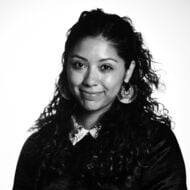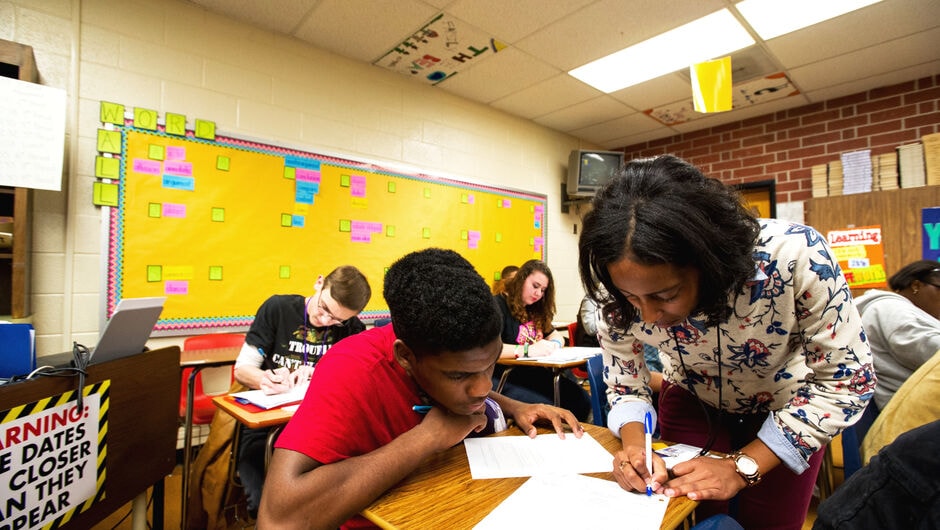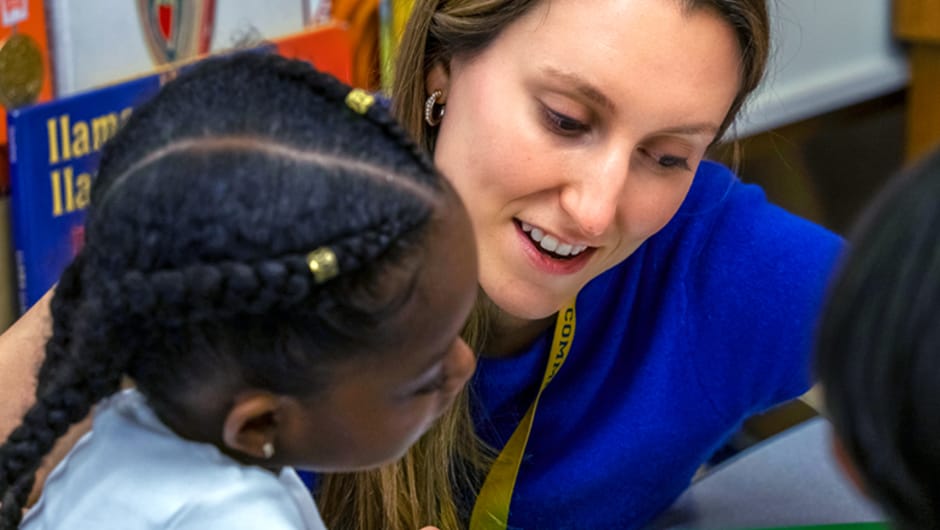
This North Carolina School Ranked First in Academic Growth. Here’s How.
Henderson Collegiate, which is led by Teach For America alumni, stresses data collecting and quarterly assessments to track student mastery.
Henderson Collegiate, a K-12 charter school in North Carolina, is beating the odds.
The school, located in rural Vance County, not only exceeded expected growth on state standardized tests. It earned the highest growth index value of every school in the state—and there are about 2,700 of them. The school achieved that growth while wrangling with challenges common to public schools: low funding, staffing shortages, and myriad setbacks related to the ongoing coronavirus pandemic. As educators across the country are trying to figure out how to accelerate the student learning that slowed during the pandemic, Henderson Collegiate students are surpassing such goals.
The school’s academic growth is part of a pattern of success. Henderson Collegiate has exceeded expected academic growth, as measured by standardized tests, since the school’s inception.
Eric and Carice Sanchez, who are married, founded the school in 2010 with the goals to raise expectations and provide an education comparable to, if not better than, affluent school districts around the country.
“On a state level and national level, we see that there are schools that are doing great things and achieving high results, and there are schools that are not who serve underserved children,” said Eric Sanchez (Eastern North Carolina, ’02), who is also the school’s CEO.
Of students enrolled at Henderson Collegiate, 90 percent are Black, Latinx, Asian or Pacific Islander, and 86 percent qualify for free or reduced lunch. For Eric Sanchez, the school provides a paradigm of what is possible in public education for disadvantaged children in rural areas.
“It's important that the proof points such as ours are out there,” Eric Sanchez said. “We really believe that kids are the constant and the teachers are the variable.”
Adults are the difference between schools where students excel and those where they falter academically, he said.
“It's important that the proof points such as ours are out there. We really believe that kids are the constant and the teachers are the variable.”
More specifically, the secret behind Henderson Collegiate’s success is creating a data-hungry school culture, Eric Sanchez said. Last school year, students began completing internal quarterly assessments, and teachers spent "hours digging into the data,” he explained. Based on results from those assessments, staff arranged classes, curricula, professional development, and tracking student progress around bridging the gaps that emerged in math and reading during the pandemic.
The school’s teachers and academic coaches identify high-priority disparities in students’ performance and then create a six-week plan to boost achievement, he said. The educators then reteach lessons, create data dashboards to track and analyze student progress, and “just keep our eyes on the data like a hawk,” Eric Sanchez said. “As soon as data would dip, then we would come up with another plan and pivot.”
Educators also block off time during the school day for interventions to give students extra practice and reviews to master lessons.
Over time, teachers became “hungrier and greedier for that type of growth,” Eric Sanchez said. “The conversation became so palpable around the building about what was happening and what we were achieving that by the time we got to the state test, we weren't surprised by the growth kids made.”
“As soon as data would dip, then we would come up with another plan and pivot.”
Get more articles like this delivered to your inbox.
The monthly ‘One Day Today’ newsletter features our top stories, delivered straight to your in-box.
Content is loading...
The Importance of Making Space for Students to Grieve
What also helped to accelerate students’ learning was a focus on their social and emotional needs, said Carice Sanchez (Eastern North Carolina, ’02), director of curriculum and instruction. Leaders hired a nurse, a social worker and counselor to support students, who were returning to fully in-person classes in the fall of 2021 for the first time since the start of the pandemic.
For the first months of school, educators focused on connection and rebuilding relationships with each other, Carice Sanchez said. They also “gave students opportunities to be able to discuss what they had been through and how to move forward. We were very intentional and strategic about creating that culture.”
It was in that culture that Kimora Hargrove, 16, was able to process grief. Last school year, she felt the heaviness of returning to school in person after having virtual classes at home earlier in the pandemic. She was struggling to focus on academics after a close acquaintance, someone in her personal life, a dance coach, died before the start of her sophomore year.
“Mentally, I wasn't ready for school, but I knew I could do it,” she said. “I did struggle. My grades weren't as best as they could be. I was always at the 70 percent mark.”
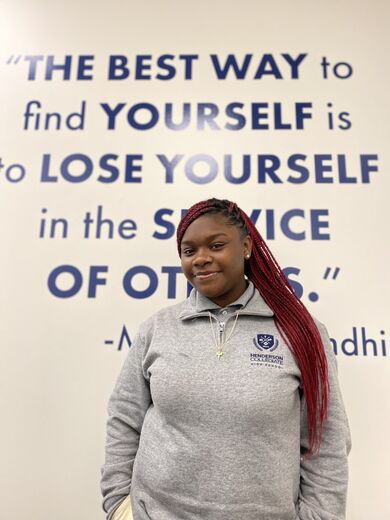
Alicia Hawk
At Henderson Collegiate, Hargrove spoke to a school counselor almost every day. She also shared what she was going through with her favorite teacher, Peter Leonard. Leonard would encourage her to recognize her potential.
“When you are too hard on yourself, you can fall in this hole,” Hargrove said.
Hargrove’s Spanish and chemistry teachers provided tutoring office hours twice a month and allowed her to retake assignments and improve her grades. By the end of last school year, she earned a mix of B’s and C’s on her report card. She also passed the English and math state tests.
“My teachers guided me,” said Hargrove, who is now a junior. “I knew what work habits to use. I wasn't in a very lost place while I was taking the test. I felt confident.”
Interested in Joining Teach For America?
She remembered test taking tips she had learned such as “slash the trash”—eliminating two incorrect multiple choice options before answering a question. On her English exam, she wrote a one-sentence summary to capture the main point of a text and reviewed test questions before reading passages so she knew what answers to look for.
Teachers Link Data to Accountability and Academic Success
As a teacher, Leonard (Eastern North Carolina, ’20) credits data tracking with helping to increase students’ success and motivation in his history classes. At the end of the third quarter, his Advanced Placement world history students take a mock test—a full, three-hour practice assessment to prepare students for the actual AP exam at the end of the course. It also “gives me as a teacher a really good chance to see where we are doing really well and where we can spend the most time addressing the gaps that are coming up,” Leonard said.
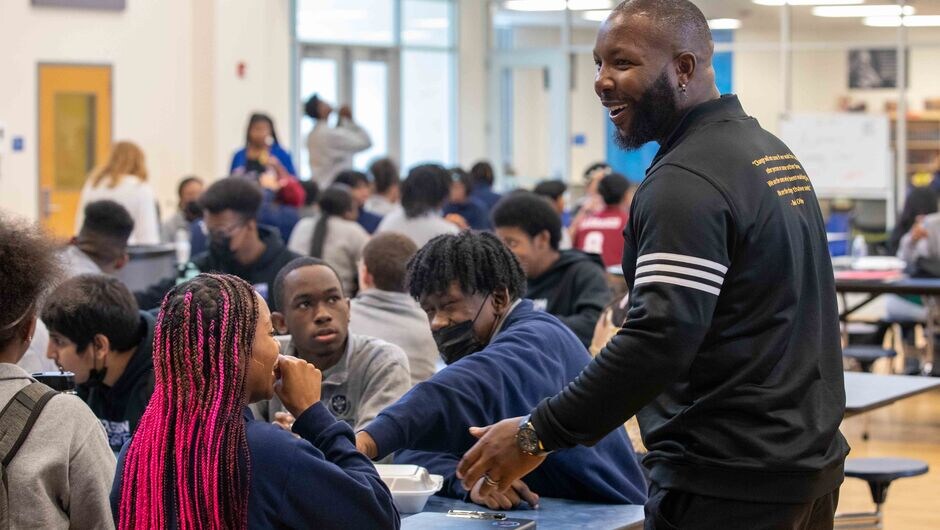

(Left) Jalil Saheeb, an English I Teacher speaks with high school students over lunch. (Right) Myrical and Galilea, second graders at Henderson Collegiate, engage in collaborative conversation about their lesson.
Courtesy of Henderson Collegiate
Leonard also changed the class schedule for the fourth quarter to give students extra academic help. He hosted tutoring hours after school and before the AP World History class. And he started a class competition modeled after the National Hockey League’s championship playoffs. Students earned prizes—including a trophy—based on the number of hours they spent studying and preparing for the exam.
The AP World History exam pass rate last school year for Leonard’s students grew by 49 percent from the previous year and was 20 percent above the national average.
“Don't be dissuaded by the idea of using data even outside of traditional STEM classes,” Leonard said, referring to science, technology, engineering and math. In history class, for example, teachers can use data to measure whether students can successfully make an argument or write a thesis. “You need to broaden your perception of what can be categorized as data, and that can lead to a lot of success,” he said.
“You need to broaden your perception of what can be categorized as data, and that can lead to a lot of success.”
Eric and Carice Sanchez attribute Henderson Collegiate’s overall success to two educator mindsets: responsibility and passion.
If teachers wanted their students to achieve more, they “actually had to put in the work,” Eric Sanchez said. “We actually had to look at the data. We had to take responsibility for what was happening. We had to push ourselves. We had to really grow in our communities, and make relationships, and become part of the community.
“Staff worked their tail off and worked harder than beyond reason because they want so much for kids. When you surround yourself with that type of love, that type of passion, that type of commitment, anything is possible,” he said. "And being No. 1 is a product of that belief.”
Sign up to receive articles like this in your inbox!
Thanks for signing up!
Content is loading...


